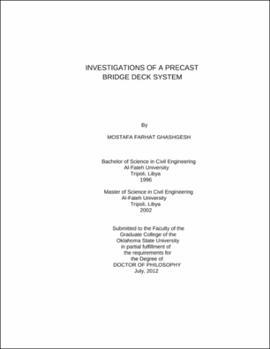Investigations of a Precast Bridge Deck System
Investigations of a precast bridge deck system
| dc.contributor.advisor | Ley, M. Tyler | |
| dc.contributor.author | Ghashgesh, Mostafa Farhat | |
| dc.date.accessioned | 2013-12-10T18:05:33Z | |
| dc.date.available | 2013-12-10T18:05:33Z | |
| dc.date.issued | 2012-07 | |
| dc.identifier.uri | https://hdl.handle.net/11244/7835 | |
| dc.description.abstract | Scope and Method of Study: | |
| dc.description.abstract | Improved methods of bridge deck construction are greatly needed. Bridge decks are often the first element to require repair or replacement because of its direct exposure to the elements and tire wear. This dissertation presents a new precast overhang system that allows for significant improvements in construction speed, economy, and safety while meeting the AASHTO requirements and providing a serviceable structure. Welded rebar mats were also investigated to replace tied reinforcing bars with partial depth panels to improve the economy, constructability, and construction speed of bridge decks. Bridge decks have been constructed and tested that have used tied reinforcing and welded rebar mats. A self-written non-linear finite element program was created to model the tested specimens and provide an alternative, economic, and time-saving tool. Strut-and-tie modeling as well as design provisions of three design codes were also used to predict failure loads. | |
| dc.description.abstract | Findings and Conclusions: | |
| dc.description.abstract | Satisfactory results were obtained, which indicate that the system will allow a support beam to be removed in certain circumstances. The improved ability of the wire mat to help resist cracking could allow an owner either greater construction tolerances for the reinforcement placement or improved crack control and hence long term durability. The proposed FE program has proven successful at modeling the performance of concrete bridge decks with interior and overhang loading. For these specimens it was found that a shear reduction factor β of 0.20 showed the best correlation with the experimental data. Additionally, it is found that the STM is the closest, in estimating failure loads and predicting the failure sequence and mode as well. FIP design recommendation was found the closest to experiments. Furthermore, it satisfactorily estimated the failure modes experimentally observed in all specimens. | |
| dc.format | application/pdf | |
| dc.language | en_US | |
| dc.rights | Copyright is held by the author who has granted the Oklahoma State University Library the non-exclusive right to share this material in its institutional repository. Contact Digital Library Services at lib-dls@okstate.edu or 405-744-9161 for the permission policy on the use, reproduction or distribution of this material. | |
| dc.title | Investigations of a Precast Bridge Deck System | |
| dc.title | Investigations of a precast bridge deck system | |
| dc.contributor.committeeMember | Russell, Bruce W. | |
| dc.contributor.committeeMember | Emerson, Robert N. | |
| dc.contributor.committeeMember | Good, J. Keith | |
| osu.filename | Ghashgesh_okstate_0664D_12229.pdf | |
| osu.accesstype | Open Access | |
| dc.type.genre | Dissertation | |
| dc.type.material | Text | |
| thesis.degree.discipline | Civil Engineering | |
| thesis.degree.grantor | Oklahoma State University |
Files in this item
This item appears in the following Collection(s)
-
OSU Dissertations [11222]
